Assessing and Mitigating Impacts of Electric Vehicle Harmonic Currents on Distribution Systems
Abstract
1. Introduction
2. Distribution Transformer Loss Modeling for Harmonic Analysis
2.1. Transformer Loss Modeling
2.2. Transformer Temperature Rise Modeling
2.3. Transformer Lifetime Modeling
3. Impact of EV Harmonic Currents on Distribution Transformers
4. Impact of EV Harmonic Currents on Distribution Transformers
4.1. System Description
4.2. Harmonic Power Flow Analysis with EV Charging Demand
4.3. Impact Assessment of EV Battery Charging on Voltage Quality
4.4. Current Total Harmonic Distortion
5. Proposed Optimal Harmonic Power Flow
5.1. Equality Constraints
5.1.1. Fundamental Power Flow Constraints
5.1.2. Harmonic Power Flow Constraints
5.2. Inequality Constraints
5.2.1. Bus Voltage Limits
5.2.2. Total Harmonic Distortion Limits
5.2.3. Individual Harmonic Distortion Limits
5.2.4. Current Limit Constraints
5.3. Performance Evaluation
6. Conclusions
Author Contributions
Funding
Conflicts of Interest
References
- Li, Y.; Xie, K.; Wang, L.; Xiang, Y. The impact of PHEVs charging and network topology optimization on bulk power system reliability. Electr. Power Syst. Res. 2018, 163, 85–97. [Google Scholar] [CrossRef]
- Kazerooni, M.; Kar, N.C. Impact analysis of EV battery charging on the power system distribution transformers. IEEE Int. Electr. Veh. Conf. IEVC 2012. [Google Scholar] [CrossRef]
- Bass, R.; Zimmerman, N. Impacts of Electric Vehicle Charging on Electric Power Distribution Systems. Oregon Transp. Res. Educ. Consort. 2013. [Google Scholar] [CrossRef]
- di Paolo, M. Analysis of harmonic impact of electric vehicle charging on the electric power grid, based on smart grid regional demonstration project-Los angeles. IEEE Green Energy Smart Syst. Conf. 2018. [Google Scholar] [CrossRef]
- Rutherford, M.J.; Yousefzadeh, V. The impact of electric vehicle battery charging on distribution transformers. Conf. Proc.-IEEE Appl. Power Electron. Conf. Expo.-APEC 2011. [Google Scholar] [CrossRef]
- Gray, M.K.; Morsi, W.G. On the impact of single-phase plug-in electric vehicles charging and rooftop solar photovoltaic on distribution transformer aging. Electr. Power Syst. Res. 2017. [Google Scholar] [CrossRef]
- Argade, S.; Aravinthan, V.; Jewell, W. Probabilistic modeling of EV charging and its impact on distribution transformer loss of life. IEEE Int. Electr. Veh. Conf. IEVC 2012. [Google Scholar] [CrossRef]
- Taci, M.S.; Sarul, M.H.; Yildirmaz, G. The effects of the harmonic components upon transformer active losses in case of (non)sinusoidal sources and (non)linear loads. IEEE Int. Conf. Ind. Technol. 2000. [Google Scholar] [CrossRef]
- Leou, R.C.; Su, C.L.; Lu, C.N. Stochastic analyses of electric vehicle charging impacts on distribution network. IEEE Trans. Power Syst. 2014, 29, 1055–1063. [Google Scholar] [CrossRef]
- Leemput, N.; Geth, F.; van Roy, J.; Delnooz, A.; Buscher, J.; Driesen, J. Impact of electric vehicle on-board single-phase charging strategies on a flemish residential grid. IEEE Trans. Smart Grid 2014, 5, 1815–1822. [Google Scholar] [CrossRef]
- Standard EN 50160 Voltage Characteristics in Public Distribution Systems. Available online: http://copperalliance.org.uk/uploads/2018/03/542-standard-en-50160-voltage-characteristics-in.pdf (accessed on 22 July 2019).
- Shafiee, S.; Fotuhi-Firuzabad, M.; Rastegar, M. Investigating the impacts of plug-in hybrid electric vehicles on power distribution systems. IEEE Trans. Smart Grid 2013, 4, 1351–1360. [Google Scholar] [CrossRef]
- Karakitsios, I.; Karfopoulos, E.; Hatziargyriou, N. Impact of dynamic and static fast inductive charging of electricvehicles on the distribution network. Electr. Power Syst. Res. 2016, 140, 104–115. [Google Scholar] [CrossRef]
- Dubey, A.; Santoso, S. Electric Vehicle Charging on Residential Distribution Systems: Impacts and Mitigations. IEEE Access 2015, 3, 1871–1893. [Google Scholar] [CrossRef]
- Sarker, M.R.; Olsen, D.J.; Ortega-Vazquez, M.A. Co-Optimization of Distribution Transformer Aging and Energy Arbitrage Using Electric Vehicles. IEEE Trans. Smart Grid 2017, 8, 2712–2722. [Google Scholar] [CrossRef]
- Obulesu, Y.P.; Reddy, M.V.; Kusumalatha, Y. A %THD analysis of industrial power distribution systems with active power filter-case studies. Int. J. Electr. Power Energy Syst. 2014, 60, 107–120. [Google Scholar] [CrossRef]
- Munir, S.M.; Li, Y.W. Residential distribution system harmonic compensation using PV interfacing inverter. IEEE Trans. Smart Grid 2013, 4, 816–827. [Google Scholar] [CrossRef]
- Bighash, E.Z.; Sadeghzadeh, S.M.; Ebrahimzadeh, E.; Blaabjerg, F. Adaptive-harmonic compensation in residential distribution grid by roof-top PV Systems. IEEE J. Emerg. Sel. Top. Power Electron. 2018, 6, 2098–2108. [Google Scholar] [CrossRef]
- IEEE. C57.110-2008-IEEE Recommended Practice for Establishing Liquid-Filled and Dry-Type Power and Distribution Transformer Capability When Supplying Nonsinusoidal Load Currents. Available online: https://standards.ieee.org/standard/C57_110-2008.html (accessed on 22 July 2019).
- Samesima, M.I.; Resende, J.W.; Araujo, S.C.N. Analysis of transformer loss of life driving nonlinear industrial loads by the finite elements approach. IEEE 2002, 3, 2175–2179. [Google Scholar] [CrossRef]
- IEEE. IEEE Std C57.91TM-2011 (Revision of IEEE Std C57.91-1995) Guide for Loading Mineral-Oil-Immersed Transformers and Step-Voltage Regulators; IEEE: Piscataway, NJ, USA, 2012. [Google Scholar]
- Said, D.M.; Nor, K.M.; Majid, M.S. Analysis of distribution transformer losses and life expectancy using measured harmonic data. Int. Conf. Harmon. Qual. Power 2010. [Google Scholar] [CrossRef]
- Baran, M.F. Network Reconfiguration in Distribution Systems for Loss Reduction and Load Balancing. IEEE Trans. Power Deliv. 1989, 4, 1401–1407. [Google Scholar] [CrossRef]
- Azzouz, M.A.; Shaaban, M.F.; El-Saadany, E.F. Real-Time Optimal Voltage Regulation for Distribution Networks Incorporating High Penetration of PEVs. IEEE Trans. Power Syst. 2015, 30, 3234–3245. [Google Scholar] [CrossRef]
- Pandi, V.R.; Zeineldin, H.H.; Xiao, W. Determining optimal location and size of distributed generation resources considering harmonic and protection coordination limits. IEEE Trans. Power Syst. 2013, 28, 1245–1254. [Google Scholar] [CrossRef]
- Society, E. IEEE Std 519-2014 (Revision of IEEE Std 519-1992), IEEE Recommended Practice and Requirements for Harmonic Control in Electric Power Systems. IEEE Std 519-2014 2014. [Google Scholar] [CrossRef]
- Sakar, S.; Balci, M.E.; Aleem, S.H.E.A.; Zobaa, A.F. Integration of large-scale PV plants in non-sinusoidal environments: Considerations on hosting capacity and harmonic distortion limits. In Renewable and Sustainable Energy Reviews; Elsevier Ltd.: Amsterdam, The Netherlands, 2018; Volume 82, pp. 176–186. [Google Scholar] [CrossRef]
- HassanzadehFard, H.; Jalilian, A. Optimal sizing and location of renewable energy based DG units in distribution systems considering load growth. Int. J. Electr. Power Energy Syst. 2018, 101, 356–370. [Google Scholar] [CrossRef]
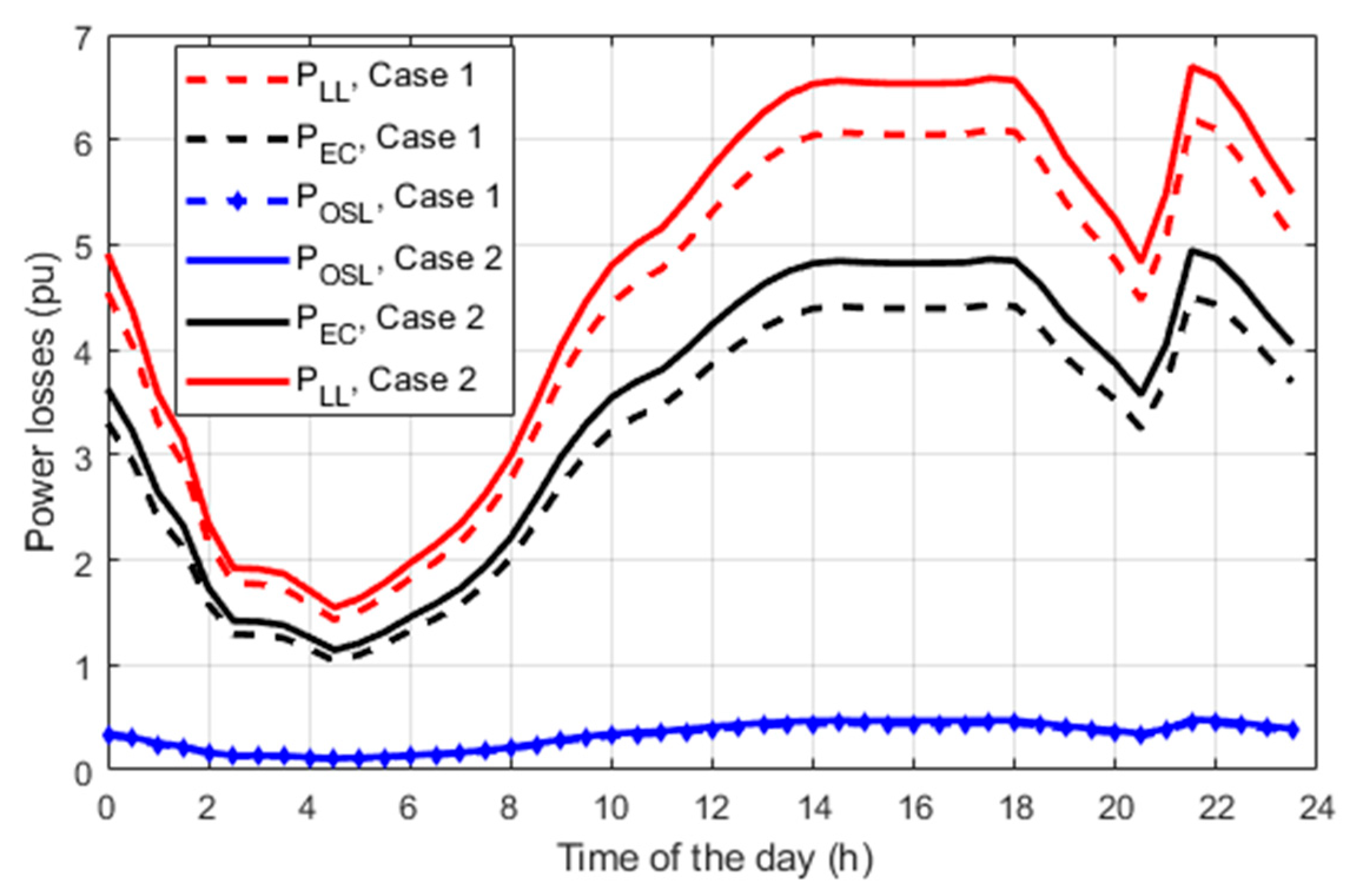
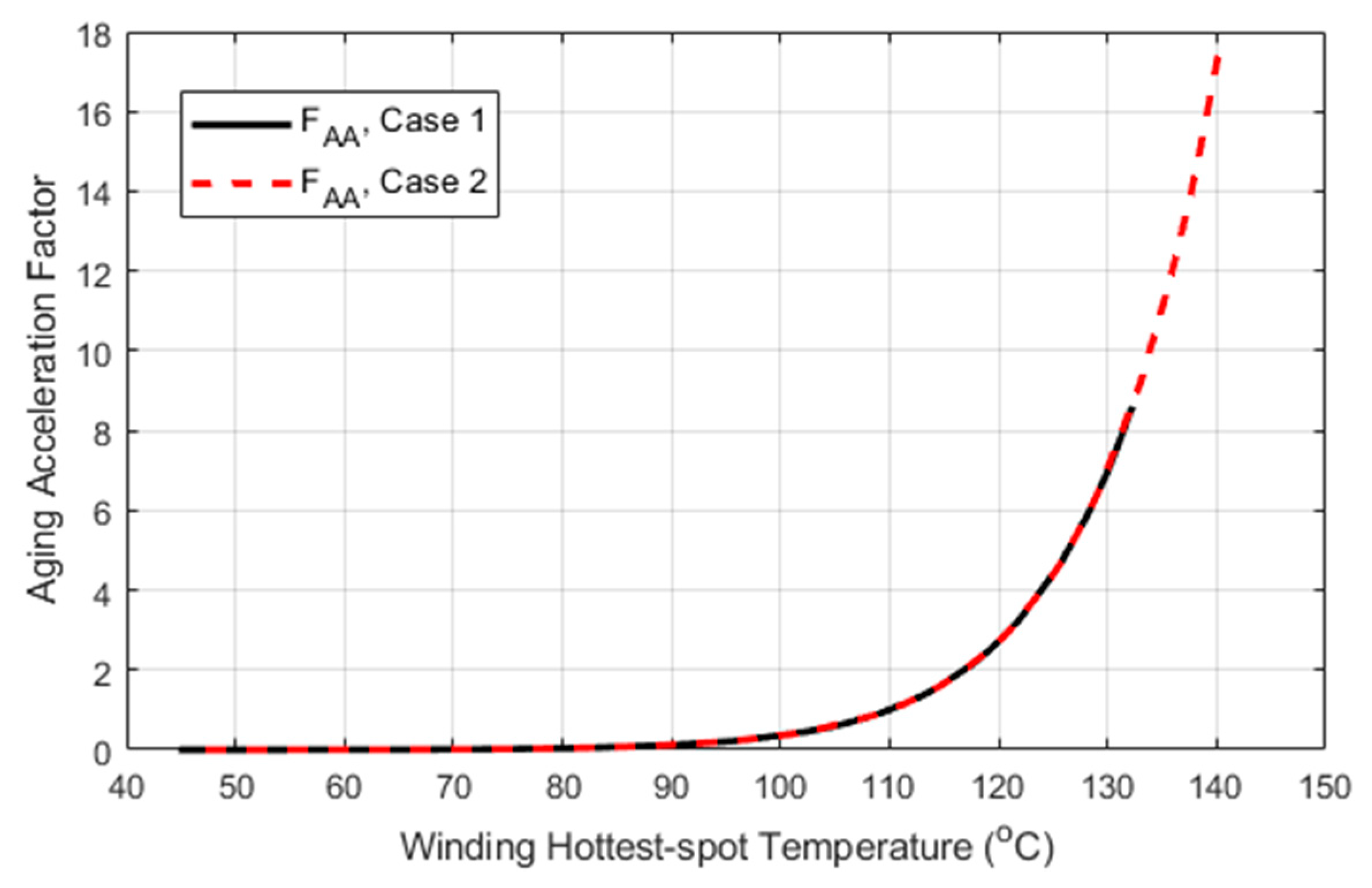



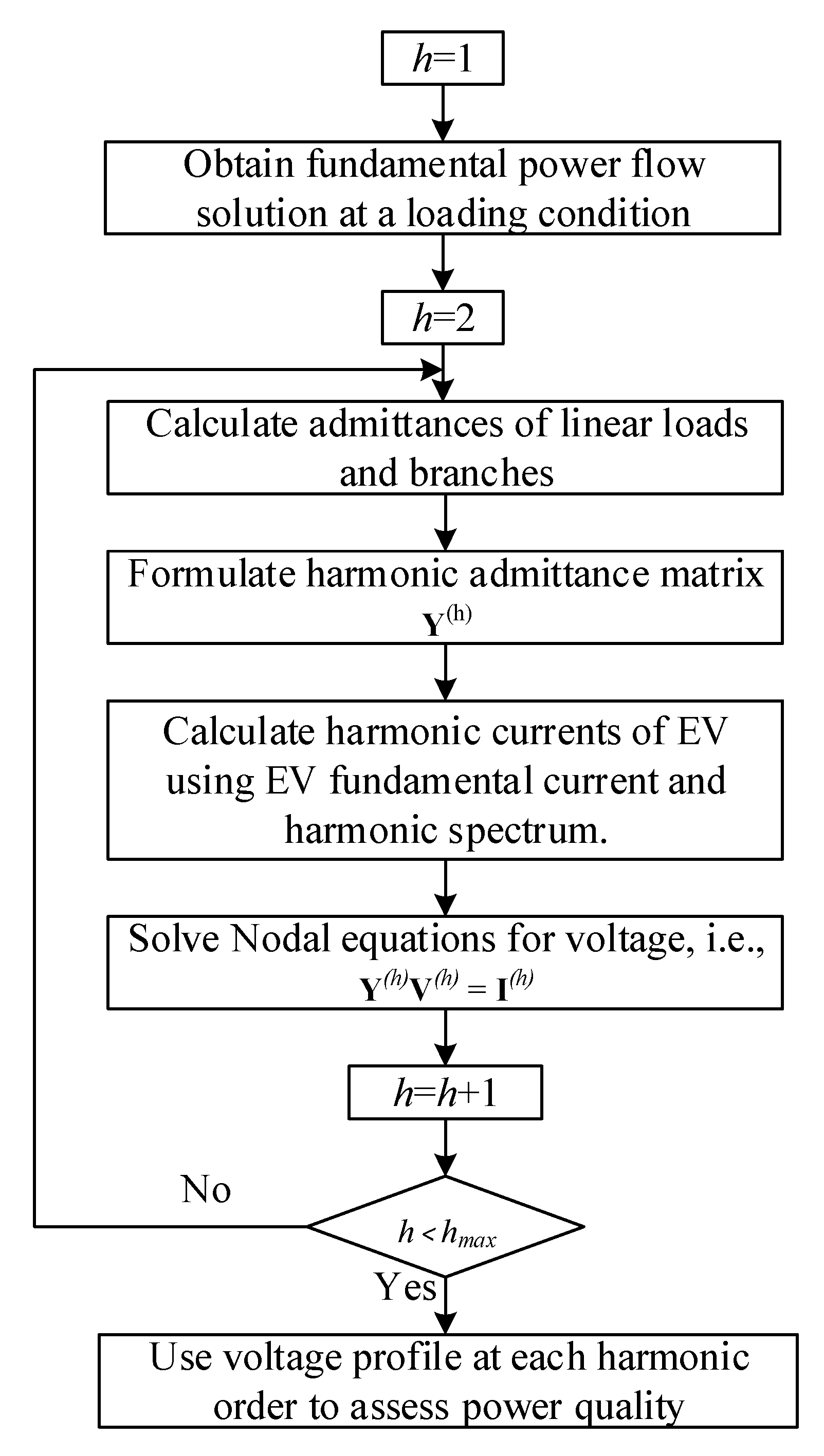
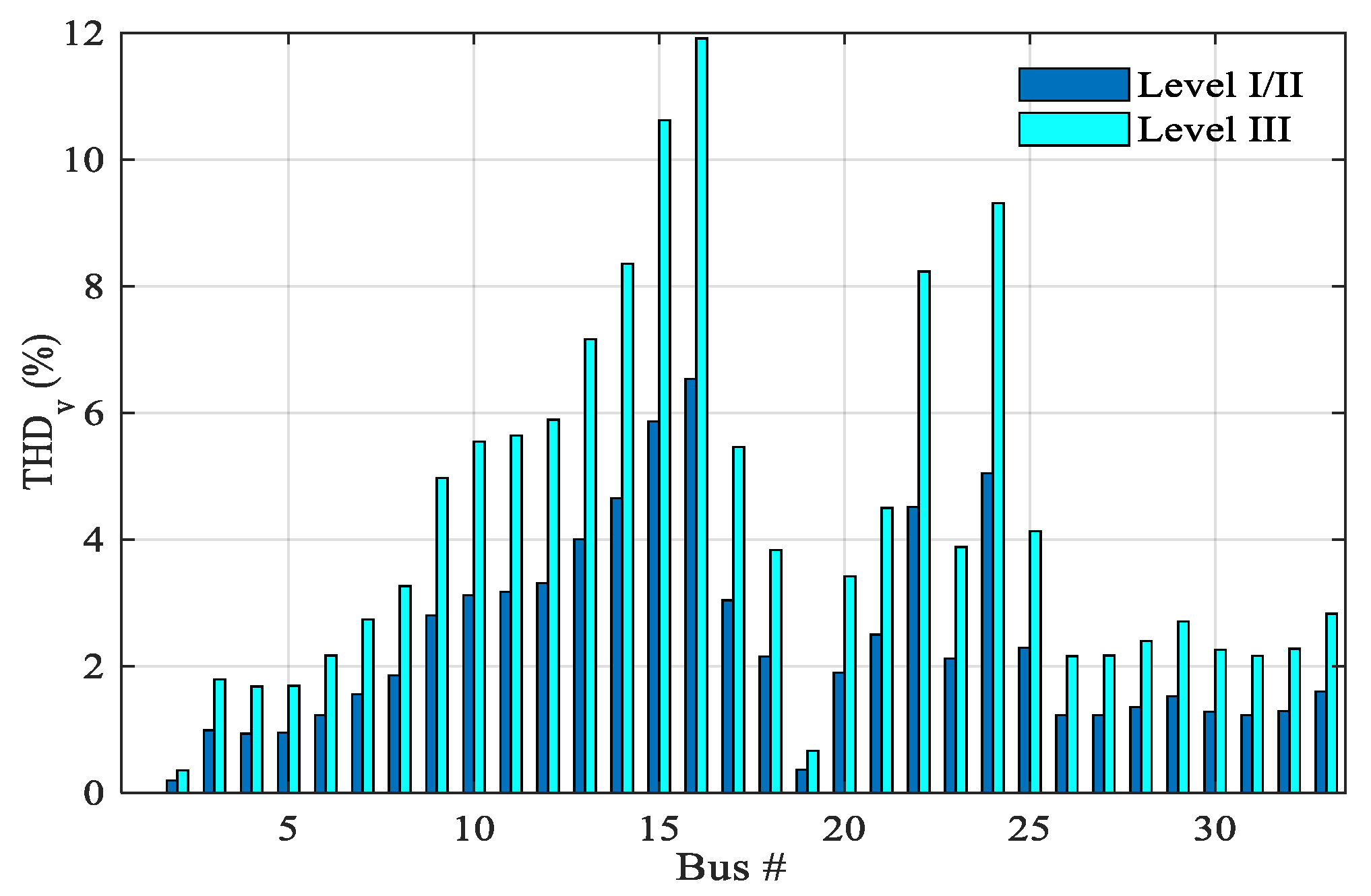
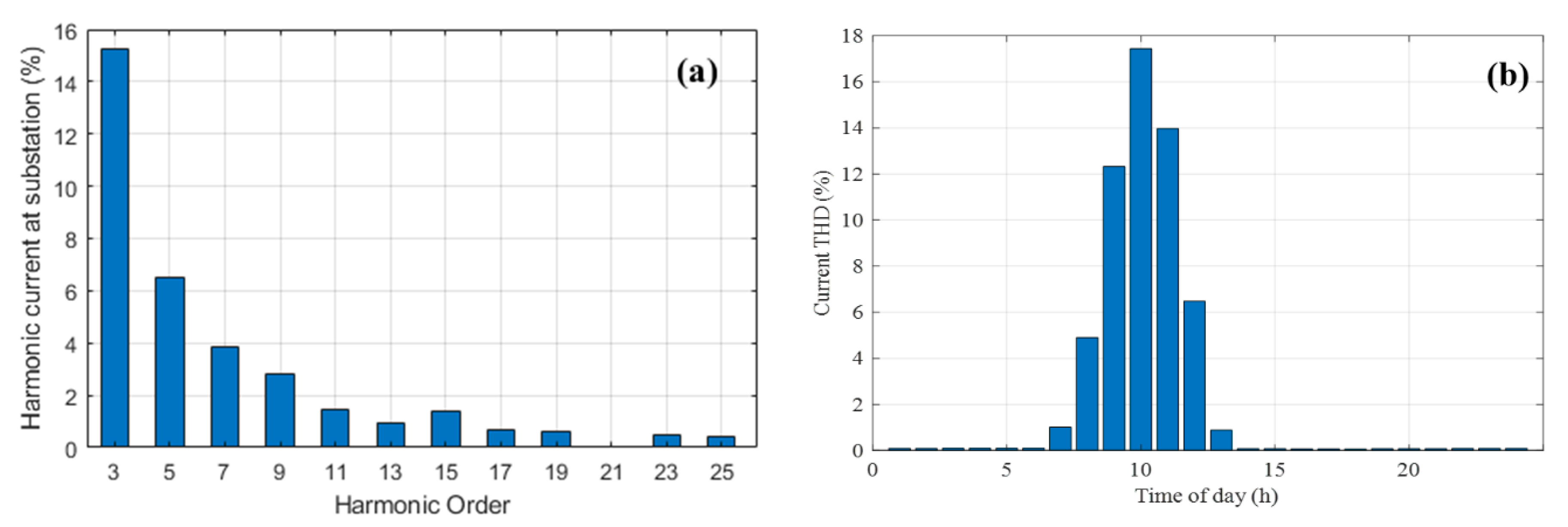

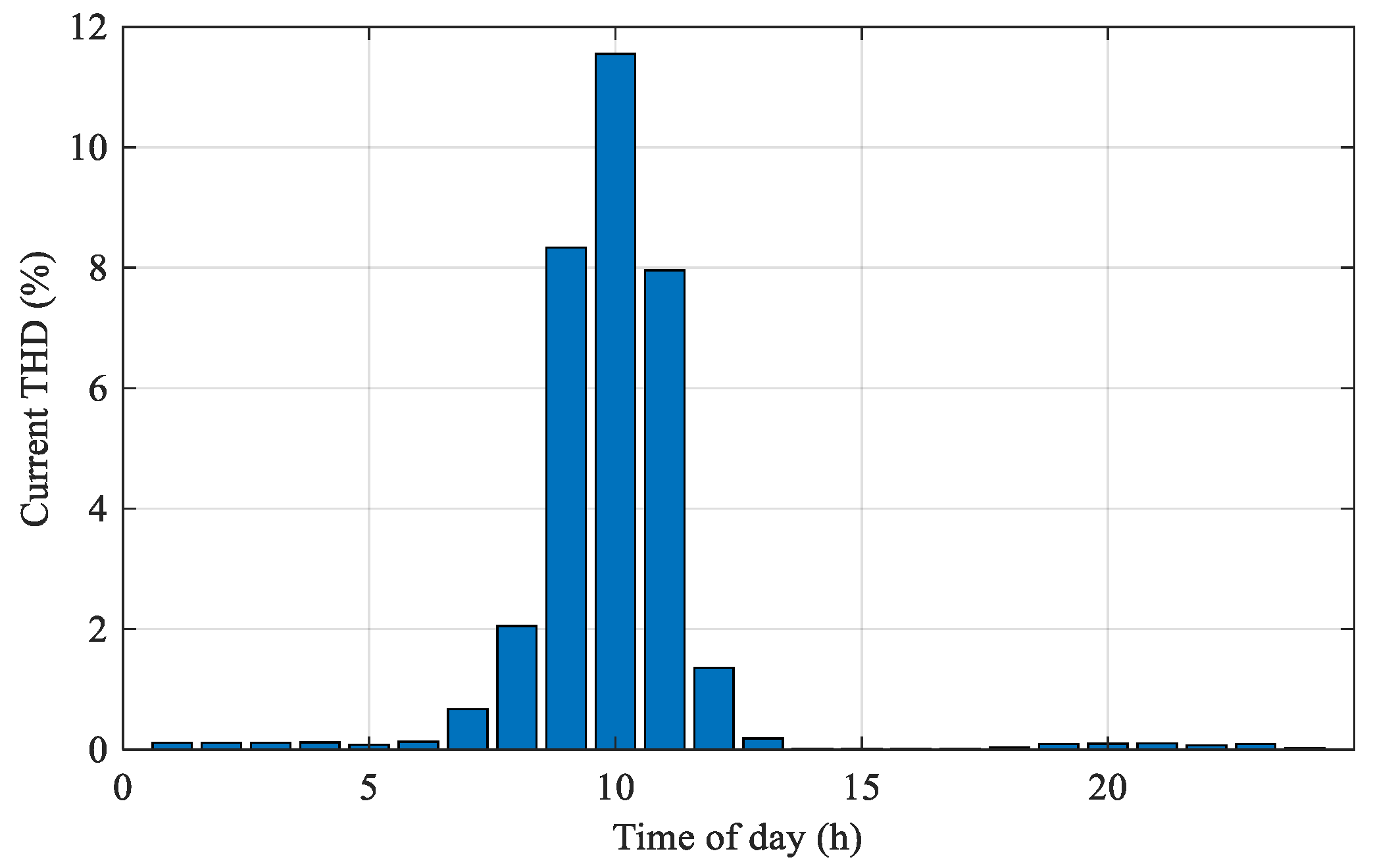
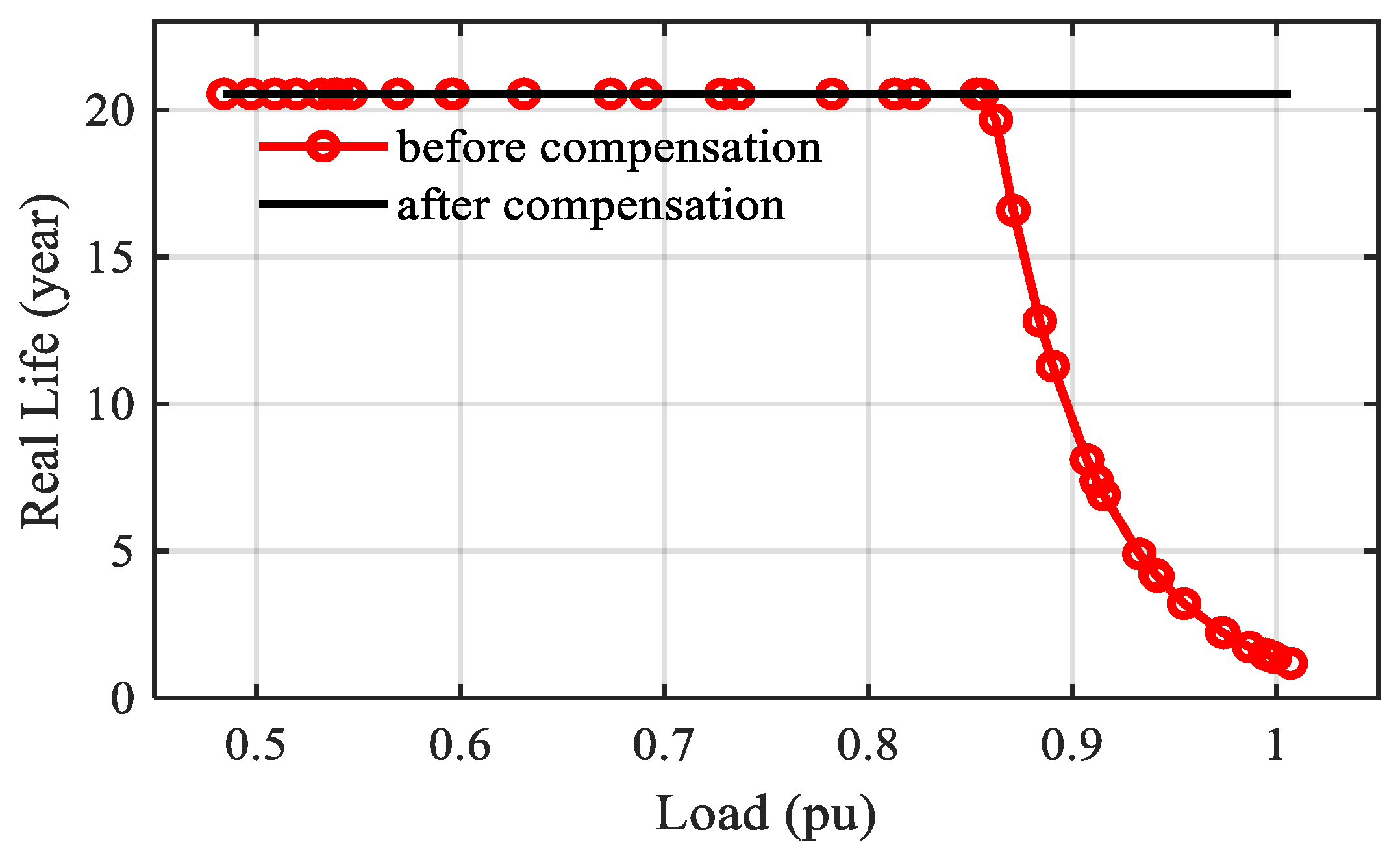
| Characteristic | Rated Value |
|---|---|
| Power | 1500 kVA |
| No Load Loss | 1600 W |
| Copper Loss | 6250 W |
| Eddy Current Loss | 3216 W |
| Other Stray Loss | 1584 W |
| Winding Temperature Rise | 65 °C |
| Ambient Temperature | 30 °C |
| Normal Insulation Life | 180,000 h |
| h | Charging Time (, minutes) | ||||||
|---|---|---|---|---|---|---|---|
| 3 | 46 | 61 | 79 | 94 | 102 | ||
| (%) | 3 | 0.27 | 1.76 | 2.04 | 2.45 | 2.33 | 11.16 |
| 5 | 1.62 | 1.56 | 2.01 | 1.83 | 2.12 | 11.87 | |
| 7 | 2.18 | 1.35 | 0.95 | 1.19 | 0.9 | 5.03 | |
| 9 | 0.53 | 0.77 | 0.65 | 0.95 | 1.56 | 5.98 | |
| h | Charging Time (, minutes) | ||
|---|---|---|---|
| 7 | 17 | ||
| (%) | 3 | 2.84 | 6.61 |
| 5 | 2.96 | 6.27 | |
| 7 | 1.81 | 4.75 | |
| 9 | 2.28 | 4.65 | |
© 2020 by the authors. Licensee MDPI, Basel, Switzerland. This article is an open access article distributed under the terms and conditions of the Creative Commons Attribution (CC BY) license (http://creativecommons.org/licenses/by/4.0/).
Share and Cite
Alame, D.; Azzouz, M.; Kar, N. Assessing and Mitigating Impacts of Electric Vehicle Harmonic Currents on Distribution Systems. Energies 2020, 13, 3257. https://doi.org/10.3390/en13123257
Alame D, Azzouz M, Kar N. Assessing and Mitigating Impacts of Electric Vehicle Harmonic Currents on Distribution Systems. Energies. 2020; 13(12):3257. https://doi.org/10.3390/en13123257
Chicago/Turabian StyleAlame, Dima, Maher Azzouz, and Narayan Kar. 2020. "Assessing and Mitigating Impacts of Electric Vehicle Harmonic Currents on Distribution Systems" Energies 13, no. 12: 3257. https://doi.org/10.3390/en13123257
APA StyleAlame, D., Azzouz, M., & Kar, N. (2020). Assessing and Mitigating Impacts of Electric Vehicle Harmonic Currents on Distribution Systems. Energies, 13(12), 3257. https://doi.org/10.3390/en13123257





